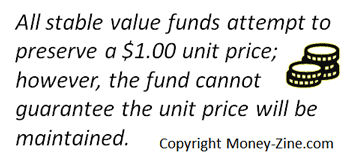Individuals looking to preserve capital, and earn a competitive rate of return on their investment, should consider investing in stable value funds. In fact, the combination of low risk and attractive returns makes investing in these funds one of the ideal ways to defend against a stock market downturn during an economic slump or credit crisis. In this article, we're going to cover the topic of stable value investments. First, we'll help to define the mix of assets typically found in these funds, as well as their investment objectives. Next, we'll discuss both the safety and risk of stable value funds. Last, we'll talk about how these funds can play an important role in the asset mix of a retirement portfolio.
Stable Value Investments
Additional Resources |
Also known as guaranteed investment contracts, fixed-income funds, capital-preservation funds, or simply as guaranteed funds, the stated objective of most stable value mutual funds is to provide investors with a competitive rate of return on their investment, while preserving principal. As defined, an investor should view these funds as a relatively safe way to earn a return on their money. But as we'll see later on, the low risk of these investments results in relatively low returns too. The typical mix of investments found in stable value funds include:
Guaranteed Investment Contracts (GIC): sold by insurance companies, these contracts guarantee the preservation of principal, while offering investors a fixed rate of interest.
Synthetic Investment Contracts (SIC): similar to GICs, except the underlying asset is owned by the plan itself and not by the insurance company (as is the case with a GIC). A synthetic investment contract attempts to simulate the performance of a GIC using a variety of financial instruments.
Fixed Income Securities: includes investments such as U.S. Treasury bonds, mortgage-backed securities, bond funds, and corporate bonds.
Money Market Investments: includes a bundle of short-term debt obligations such as certificates of deposit and U.S. Treasury bills.

All stable value funds attempt to preserve a $1.00 unit price, however, the fund cannot guarantee the unit price will be maintained. Investors looking to benchmark the performance of these funds should compare their returns to intermediate-term bond funds or money market funds.
Safety and Returns
Investors should expect lower returns in exchange for the lower risk of a stable value fund. According to the Stable Value Investment Association, the average return over the 20-year timeframe from 1993 through 2013 was 5.65% compared to 8.66% for large stocks. But just how safe are these investments? In the case of investment contracts, insurance companies guarantee the rate of return to investors. Even when these investments under-perform in a given year, most insurance companies would rather lose money on their contracts then risk defaulting on their payments. That being said, if the insurance company is in danger of filing for bankruptcy, then the investor's return, as well as principal, is at risk. Financial instruments such as money market funds typically include very high quality, short-term corporate bonds or securities backed by the U.S. government. Here the risk of default is very small, making the investment extremely safe.
Retirement Income
The typical investor in a stable value fund is an individual looking for a safe or low risk fund that offers a reasonable rate of return on their money. Stable value funds are frequently offered as an option in an employer's 401(k) or 403(b) plan. In fact, according to the Stable Value Investment Association, half of all 401(k) plans offer participants this option. In 2020, there were $807 billion invested in these accounts. Stable value funds also play an important role in retirement portfolios. That's because these funds are able to provide their owners with a steady source of monthly income even during economic recessions or when a credit crisis occurs. The worst time to sell equities is during a market downturn. A well-balanced portfolio of stocks, bonds, and stable value funds allows a retiree to weather an economic storm without the need to sell stocks at bargain prices. Anyone wondering whether a stable value fund should play a part in their investment or retirement portfolio should run through some what-if scenarios using our asset allocation calculator. That tool uses several simple standardized rules to calculate a risk tolerance score. Based on that score, the tool will provide an asset allocation result that includes stocks, bonds, and cash / money market funds; the last of which is frequently offered to retirement plan participants as a stable value fund.
About the Author - Stable Value Funds



.jpg)
.jpg)